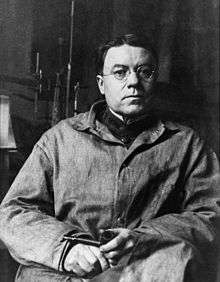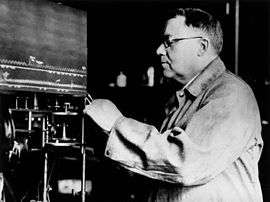Walter Bradford Cannon
| Walter Bradford Cannon | |
|---|---|
 | |
| Born |
October 19, 1871 Prairie du Chien, Wisconsin |
| Died |
October 1, 1945 (aged 73) Franklin, New Hampshire |
| Nationality | American |
| Fields | Physiology |
| Institutions | Harvard Medical School |
| Education |
Harvard University (1896) Harvard Medical School (1900, M.D.) |
| Known for |
Homeostasis Fight or flight X ray experiments Cannon–Bard theory Voodoo death |
| Notable awards | Fellow of the Royal Society,[1] Member of the National Academy of Sciences, USA Member of National Academy of Sciences, USSR |
| Spouse | Cornelia James Cannon |
Walter Bradford Cannon (October 19, 1871 – October 1, 1945) was an American physiologist, professor and chairman of the Department of Physiology at Harvard Medical School. He coined the term fight or flight response, and he expanded on Claude Bernard's concept of homeostasis. He popularized his theories in his book The Wisdom of the Body, first published in 1932. A Review of General Psychology survey, published in 2002, ranked Cannon as the 81st most cited scholar of the 20th century in technical psychology journals, introductory psychology textbooks, and survey responses.[2][3]
Biography
Cannon was born in Prairie du Chien, Wisconsin on October 19, 1871, the son of Colbert Hanschett Cannon and his wife Wilma Denio.[4]
In his autobiography The Way of an Investigator, Cannon counts himself among the descendents of Jacques de Noyon, a French Canadian explorer and coureur des bois. His Calvinist family was intellectually active, including readings from James Martineau, John Fiske (philosopher), and James Freeman Clarke. Cannon's curiosity also led him to Thomas Henry Huxley, John Tyndall, George Henry Lewes, and William Kingdon Clifford.[5] A high school teacher, Mary Jeannette Newson, became his mentor. "Miss May" Newson motivated and helped him take his academic skills to Harvard University.[6]
In 1896, his first year at Harvard Medical School, he started working in Bowditch's Lab,[7] and in 1900 he received his medical degree.
After graduation, Cannon was hired by Harvard to instruct in the Department of Physiology. He was a close friend of the physicist G. W. Pierce; they founded the Wicht Club with other young instructors for social and professional purposes. In 1906 Cannon became Higginson Professor and chairman of the Department of Physiology at Harvard Medical School, a position he held until 1942. From 1914 to 1916 he was also President of the American Physiological Society.[7]
He was married to Cornelia James Cannon, a best-selling author and feminist reformer. Although not mountaineers, during their honeymoon in Montana the couple were the first, on July 19, 1901, to reach the summit of the unclimbed southwest peak (2657 m or 8716 ft) of Goat Mountain, between Lake McDonald and Logan Pass in what is now Glacier National Park. The peak was subsequently named Mount Cannon by the United States Geological Survey[8] The couple had five children. One son was Dr. Bradford Cannon, a military plastic surgeon and radiation researcher. The daughters are Wilma Cannon Fairbank (Mrs. John K. Fairbank), Linda Cannon Burgess, Helen Cannon Bond and Marian Cannon Schlesinger, a painter and author living in Cambridge, Massachusetts.
Walter Cannon died on October 1, 1945 in Franklin, New Hampshire.[9]
Work

Walter Cannon began his career in science as a Harvard undergraduate in the year 1896. Henry Pickering Bowditch, who had worked with Claude Bernard, directed the laboratory in physiology at Harvard. Here Cannon began his research: he used the newly discovered X rays to study the mechanism of swallowing and the motility of the stomach. He demonstrated deglutition in a goose at the APS meeting in December 1896 and published his first paper on this research in the first issue of the American Journal of Physiology in January 1898.[7]
In 1945 Cannon summarized his career in physiology by describing his focus at different ages:[10]
- Age 26 – 40: digestion and the bismuth meal
- Age 40 – 46: bodily effects of emotional excitement
- Age 46 – 51: wound shock investigations
- Age 51 – 59: stable states of the organism
- Age 59 – 68: chemical mediation of nerve impulses (collaboration with Arturo Rosenblueth)
- Age 68 + : chemical sensitivity of nerve-isolated organs
Scientific contributions
- Use of salts of heavy metals in X-Rays
- He was one of the first researchers to mix salts of heavy metals (including bismuth subnitrate, bismuth oxychloride, and barium sulfate) into foodstuffs in order to improve the contrast of X-ray images of the digestive tract. The barium meal is a modern derivative of this research.
- Fight or flight
- In 1915, he coined the term fight or flight to describe an animal's response to threats in Bodily Changes in Pain, Hunger, Fear and Rage: An Account of Recent Researches into the Function of Emotional Excitement.[11]
- Homeostasis
- He developed the concept of homeostasis from the earlier idea of Claude Bernard of milieu interieur, and popularized it in his book The Wisdom of the Body,1932. Cannon presented four tentative propositions to describe the general features of homeostasis:
- Constancy in an open system, such as our bodies represent, requires mechanisms that act to maintain this constancy. Cannon based this proposition on insights into the ways by which steady states such as glucose concentrations, body temperature and acid-base balance were regulated.
- Steady-state conditions require that any tendency toward change automatically meets with factors that resist change. An increase in blood sugar results in thirst as the body attempts to dilute the concentration of sugar in the extracellular fluid.
- The regulating system that determines the homeostatic state consists of a number of cooperating mechanisms acting simultaneously or successively. Blood sugar is regulated by insulin, glucagons, and other hormones that control its release from the liver or its uptake by the tissues.
- Homeostasis does not occur by chance, but is the result of organized self-government.
- Cannon-Bard theory
- Cannon developed the Cannon-Bard theory with physiologist Philip Bard to try to explain why people feel emotions first and then act upon them.
- Dry mouth
- He put forward the Dry Mouth Hypothesis, stating that people get thirsty because their mouths get dry. He did an experiment on two dogs. He made incisions in their throats and inserted small tubes. Any water swallowed would go through their mouths and out by the tubes, never reaching their stomachs. He found out that these dogs would lap up the same amount of water as control dogs.
Publication
Cannon wrote several books and articles.
- 1910, A Laboratory Course in Physiology
- 1911, The Mechanical Factors of Digestion
- 1915, Bodily Changes in Pain, Hunger, Fear and Rage
- 1923, Traumatic Shock
- 1931, Lazaro in the pueblos: the story of Antonio de Espejo's expedition into New Mexico
- 1932, The Wisdom of the Body
- 1936, Digestion and Health
- 1937, Autonomic Neuro-effector Systems, with Arturo Rosenblueth
- 1942, "Voodoo" Death
- 1945, The Way of an Investigator
References
- ↑ Dale, H. H. (1947). "Walter Bradford Cannon. 1871-1945". Obituary Notices of Fellows of the Royal Society. 5 (15): 407–426. doi:10.1098/rsbm.1947.0008.
- ↑ Haggbloom, Steven J.; Warnick, Jason E.; Jones, Vinessa K.; Yarbrough, Gary L.; Russell, Tenea M.; Borecky, Chris M.; McGahhey, Reagan; et al. (2002). "The 100 most eminent psychologists of the 20th century". Review of General Psychology. 6 (2): 139–152. doi:10.1037/1089-2680.6.2.139.
- ↑ Haggbloom, Steven J. "Steven J. Haggbloom - Psychology - WKU". Western Kentucky University.
- ↑ https://www.royalsoced.org.uk/cms/files/fellows/biographical_index/fells_indexp1.pdf
- ↑ Way of an Investigator, pp. 16–7
- ↑ Saul Benison, A. Clifford Barger, Elin L. Wolfe (1987) Walter B. Cannon: the Life and Times of a Young Scientist. pp.16–32, Belknap Press.
- 1 2 3 "Walter Bradford Cannon". Presidents. American Physiological Society. Retrieved 22 March 2015.
6th APS President (1914-1916)
- ↑ Fred Spicker, Moni (June 19, 2011). "Mount Cannon (MT)". SummitPost. Retrieved May 10, 2012.
- ↑ "Dr. W.B. Cannon, 73, Neurologist, Dead. Harvard Psychology Professor for 36 Years Noted for His Work on Traumatic Shock Became Professor in 1906". New York Times. October 2, 1945. Retrieved October 5, 2010.
Dr. Walter Bradford Cannon of Cambridge, Mass., George Higginson Professor Emeritus of Psychology as the Harvard Medical School and a member of the Harvard Epilepsy Commission, died here today in his summer home. He would have been 74 years old on Oct. 19.
- ↑ On page 218 of his book The Way of an Investigator,
- ↑ Walter Bradford Cannon (1915). Bodily Changes in Pain, Hunger, Fear and Rage: An Account of Recent Researches into the Function of Emotional Excitement. Appleton.
Further reading
- Saul Benison, A. Clifford Barger, Elin L. Wolfe (1987) Walter B. Cannon: the Life and Times of a Young Scientist, [ISBN 0674945808].
- Elin L. Wolfe, A. Clifford Barger, Saul Benison (2000) Walter B. Cannon, Science and Society, [ISBN 0674002512].
- Walter Bradford Cannon: Reflections on the Man and His Contributions, International Journal of Stress Management, Vol. 1, No. 2, 1994
- Marian Cannon Schlesinger, Snatched from Oblivion: A Cambridge Memoir, Boston: Little, Brown and Company, 1979
External links
| Wikimedia Commons has media related to Walter Bradford Cannon. |
- Works by or about Walter Bradford Cannon at Internet Archive
- 6th APS President at the American Physiological Society
- Walter Bradford Cannon: Experimental Physiologist, a biographical article by Edric Lescouflair, dated 2003
- Chapter 9 of Explorers of the Body, by Steven Lehrer (contains information about X ray experiments)
- The Walter Bradford Cannon papers can be found at The Center for the History of Medicine at the Countway Library, Harvard Medical School.
- Walter Bradford Cannon, Homeostasis (1932)